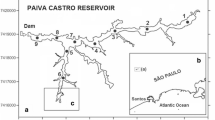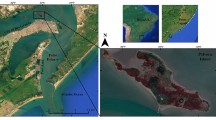Abstract
Sediment and porewater samples (1997–1999) were collected in the Northern Reach of the San Francisco Bay and Sacramento–San Joaquin Delta for determinations of sedimentary selenium and its chemical speciation. Total sedimentary selenium increased with depth, with approximately 50% of the sedimentary selenium as elemental selenium and 35% as organic selenide. Porewater total dissolved selenium increased with depth in the estuary and Delta, and fluxes out of the sediments were calculated at 0.01 and 0.06 nmol cm−2 year−1 for the estuary and Delta, respectively. Present-day sediment–water exchange of dissolved selenium and internal transformations cannot explain the observed increase in total sedimentary selenium with depth. However, mass balance calculations demonstrate that the increase in total selenium with depth may be linked to higher dissolved selenium concentrations in the water column in the 1980s, suggesting that the sediments could be used as historical recorders of selenium in the estuary.






Similar content being viewed by others
References
Alexander, Clark R., Ralph G. Smith, Steven Schropp, Fred D. Calder, and Herbert L. Windom. 1993. The historical record of metal enrichment in two Florida estuaries. Estuaries 16: 627–637.
Amouroux, David and Olivier F.X. Donard. 1997. Evasion of selenium to the atmosphere via biomethylation processes in the Gironde estuary, France. Marine Chemistry 58: 173–188.
Amouroux, David, Christophe Pécheyran, and Olivier F.X. Donard. 2000. Formation of volatile selenium species in synthetic seawater under light and dark experimental conditions. Applied Organometallic Chemistry 14: 236–244.
Baines, Stephen B., Nicholas S. Fisher, Martina A. Doblin, and Gregory A. Cutter. 2001. Uptake of dissolved organic selenides by marine phytoplankton. Limnology and Oceanography 46: 1936–1944.
Belzile, Nelson, and Jean Lebel. 1988. Selenium profiles in the sediments of the Laurentian trough (Northwest North Atlantic). Chemical Geology 68: 99–103.
Belzile, Nelson, Yu-Wei Chen, and Rongrong Xu. 2000. Early diagenetic behaviour of selenium in freshwater sediments. Applied Geochemistry 15: 1439–1454.
Bender, Michael, William Martin, Jennifer Hess, Fred Sayles, Larry Ball, and Claude Lambert. 1987. A whole core squeezer for interfacial pore-water sampling. Limnology and Oceanography 32: 1214–1225.
Berner, Robert A. 1980. Early diagenesis: A theoretical approach. Princeton: Princeton University Press.
Conomos, T. John, and David H. Peterson. 1977. Suspended-particle transport and circulation in San Francisco Bay: an overview. Estuarine Processes Vol. II; Circulation, Sediments, and Transfer of Material in the Estuary. New York: Academic Press, Inc.
Conomos, T. John, Richard E. Smith, and Jeffrey W. Gartner. 1985. Environmental setting of San Francisco Bay. Hydrobiologia 129: 1–12.
Cutter, Gregory A. 1978. Species determination of selenium in natural waters. Analytica Chimica Acta 98: 59–66.
Cutter, Gregory A. 1982. Selenium in reducing waters. Science 217: 829–831.
Cutter, Gregory A. 1983. Elimination of nitrite interferences in the determination of selenium by hydride generation. Analytica Chimica Acta 149: 391–394.
Cutter, Gregory A. 1985. Determination of selenium speciation in biogenic particulate material and sediments. Analytical Chemistry 57: 2951–2955.
Cutter, Gregory A. 1989. The estuarine behaviour of selenium in San Francisco Bay. Estuarine, Coastal and Shelf Science 28: 13–34.
Cutter, Gregory A., and Kenneth W. Bruland. 1984. The marine biogeochemistry of selenium in a simple system. Geochimica et Cosmochimica Acta 48: 1417–1433.
Cutter, Gregory A., and Lynda Cutter. 1995. Behavior of dissolved antimony, arsenic, and selenium in the Atlantic Ocean. Marine Chemistry 49: 295–306.
Cutter, Gregory A., and Lynda Cutter. 2004. The biogeochemistry of selenium in the San Francisco Bay estuary: changes in water column behavior. Estuarine, Coastal and Shelf Science 61: 463–476.
Cutter, Gregory A., and Joël Radford-Knoery. 1991. Determination of carbon, nitrogen, sulfur, and inorganic sulfur species in marine particles. In Marine particles: analysis and characterization, eds. Derek W. Spencer and David C. Hurd, 57–63. Washington, DC: American Geophysical Union.
Cutter, Gregory A., and Maria L.C. San Diego-McGlone. 1990. Temporal variability of selenium fluxes in the San Francisco Bay. Science of the Total Environment 97: 235–250.
Doblin, Martina A., Stephen B. Baines, Lynda S. Cutter, and Gregory A. Cutter. 2006. Sources and biochemical cycling of particulate selenium in the San Francisco Bay estuary. Estuarine and Coastal Shelf Science 67: 681–694.
Dowdle, Philip R., and Ronald S. Oremland. 1998. Microbial oxidation of elemental selenium in soil slurries and bacterial cultures. Environmental Science and Technology 32: 3749–3755.
Duan, Liqin, Jinming Song, Xuegang Li, Huamao Yuan, and Sisi Xu. 2010. Distribution of selenium and its relationship to the eco-environment in Bohai Bay seawater. Marine Chemistry 121: 87–99.
Elrashidi, M.A., D.C. Adriano, S.M. Workman, and W.L. Lindsay. 1987. Chemical equilibrium of selenium in soils: a theoretical development. Soil Science 144: 141–152.
Engber, R.A. 1997. Remediation of irrigation-related contamination at department of the interior project area in the western United States. In Agroecosystems and the environment: sources, control and remediation of potentially toxic, trace element oxyanions, ed. L.M. Dudley and J.C. Guitjens, 57–76. San Francisco: American Association Advancement Science-Pacific Division.
Fan, Teresa W.M., Swee J. Teh, David E. Hinton, and Richard M. Higashi. 2002. Selenium biotransformations in to proteinaceous forms by foodweb organisms of selenium laden drainage waters in California. Aquatic Toxicology 57: 65–84.
Geering, Harold R., Earle E. Cary, L.H.P. Jones, and W.H. Allaway. 1968. Solubility and redox criteria for the possible forms of selenium in soils. Soil Science of America Journal 32: 35–40.
Hu, Minghui, Yiping Yang, Genfang Wang, and J.M. Martin. 1996. Chemical behaviour of selenium in Jiulong Estuary. Journal of Oceanography in Taiwan Strait/Taiwan Haixia 15: 41–47.
Huang, Shunsheng, Ming Hua, Jinshun Feng, Xinyong Zhong, Yang Jin, Baiwan Zhu, and Hua Lu. 2009. Assessment of selenium pollution in agricultural soils in the Xuzhou District, Northwest Jiangsu, China. Journal of Environmental Sciences 21: 481–487.
Hung, J.J. and C.P. Shy. 1995. Speciation of dissolved selenium in the Kaoping and Erhjen Rivers and Estuaries, Southwestern Taiwan. Estuaries 18: 234–240.
Johns, Carolyn, Samuel N. Luoma, and Virginia Elrod. 1988. Selenium accumulation in benthic bivalves and fine sediments of San Francisco Bay, the Sacramento-San Joaquin Delta, and selected tributaries. Estuarine, Coastal and Shelf Science 27: 381–396.
Lee, Byeong-Gweon, Jung-Suk Lee, and Samuel N. Luoma. 2006. Comparison of selenium bioaccumulation in the clams Corbicula fluminea and Potamocorbula amurensis: A bioenergetic modeling approach. Environmental Toxicology and Chemistry 25: 1933–1940.
Lemly, A. Dennis. 1996. Assessing the toxic threat of selenium to fish and aquatic birds. Environmental Monitoring Assessments 43: 19–35.
Li, Yuan-Hui, and Sandra Gregory. 1974. Diffusion of ions in sea water and in deep sea sediments. Geochimica et Cosmochimica Acta 38: 703–714.
Linville, Regina G., Samuel N. Luoma, Lynda S. Cutter, and Gregory A. Cutter. 2002. Increased selenium threat as a result of invasion of the exotic bivalve Potamocorbula amurensis into the San Francisco Bay Delta. Aquatic Toxicology 57: 51–64.
Martin, Alan J., Stephanie Simpson, Skya Fawcett, Cheryl I.E. Wiramanaden, Ingrid J. Pickering, Nelson Belzile, Y.W. Chen, Jacqueline London, and Dirk Wallschläger. 2011. Biogeochemical mechanisms of selenium exchange between water and sediments in two contrasting lentic environments. Environmental Science and Technology 45: 2605–2612.
Matamoros-Veloza, Adriana , Robert J. Newton, and Liane G. Benning. 2011. What controls selenium release during shale weathering? Applied Geochemistry 26: S222-S226.
McKee, Lester, Neil Ganju, and David Shoellhammer. 2006. Estimates of suspended sediment entering San Francisco Bay from the Sacramento and San Joaquin Delta, San Francisco Bay, California. Journal of Hydrology 323: 335–352.
Miao, Xiu-Sheng, Lee A. Woodward, Chris Swenson, and Qing X. Li. 2001. Comparative concentrations of metals in marine species from French Frigate Shoals, North Pacific Ocean. Marine Pollution Bulletin 42: 1049–1054.
Ohlendorf, Harry M., Roy W. Lowe, Paul R. Kelly, and Thomas E. Harvey. 1986. Selenium and heavy metals in San Francisco diving ducks. Journal of Wildlife Management 50: 64–71.
Oremland, Ronald S., James T. Hollibaugh, Ann S. Maest, Theresa S. Presser, Laurence G. Miller, and Charles W. Culbertson. 1989. Selenate reduction to elemental selenium, by anaerobic bacteria in sediments and cultures: biogeochemical significance of a novel, sulfate-independent respiration. Applied Environmental Microbiology 55: 2333–2343.
Peters, G.M., W.A. Maher, F. Krikowa, A.C. Roach, H.K. Jeswani, J.P. Barford, V.G. Gomes, and D.D. Reible. 1999. Selenium in sediments, pore waters and benthic infauna of Lake Macquarie, New South Wales, Australia. Marine Environmental Research 47: 491–508.
Reamer, D.C., and W.H. Zoller. 1980. Selenium biomethylation products from soil and sewage sludge. Science 208: 500–502.
Schults, Donald W., Steven P. Ferraro, Lawrence M. Smith, Fredrick A. Roberts, and Carolyn K. Poindexter. 1992. A comparison of methods for collecting interstitial water for trace organic compounds and metals analyses. Water Research 26: 989–995.
Shumilin, Evgueni, Federico Páez-Osuna, Carlos Green-Ruiz, Dmitry Sapozhnikov, Guadalupe D. Rodriquez-Meza, and Lucio Godinez-Orta. 2001. Arsenic, antimony, selenium and other trace elements in sediments of the La Paz Lagoon, Peninsula of Baja California, Mexico. Marine Pollution Bulletin 42: 174–178.
Skorupa, Joseph P. 1998. Selenium poisoning of fish and wildlife in nature: lessons from twelve real-world examples. In Environmental chemistry of selenium, eds. William T. Frankenberger Jr, and Richard A. Engberg, 315–354. New York: Marcel Dekker Inc.
Sokolova, Y.G., and M.D. Pilipchuk. 1973. Geochemistry of selenium in sediments in the N.W. part of the Pacific Ocean. Geochemistry International 10: 1537–1546.
Stolz, J.P., P. Basu, and R. Oremland. 2002. Microbial transformation of elements: the case of arsenic and selenium. International Microbiology 5: 201–207.
Takayanagi, Kazufumi, and Nelson Belzile. 1988. Profiles of dissolved and acid-leachable selenium in a sediment core from the lower St. Lawrence estuary. Marine Chemistry 24: 307–314.
Takayanagi, Kazufumi, and D. Cossa. 1985. Speciation of dissolved selenium in the upper St. Lawrence Estuary. In Marine and estuarine geochemistry, eds. Anne C. Siglo and Akihiko Hattori, 275–284. Michigan: Lewis Publishers, Inc.
Thompson, J.K. 2000. Two stories of phytoplankton control by bivalves in San Francisco Bay: the importance of spatial and temporal distribution of bivalves. Journal of Shellfish Research 19: 612.
Ullman, William J., and Robert C. Aller. 1982. Diffusion coefficients in nearshore marine sediments. Limnology and Oceanography 27: 552–556.
van Geen, Alexander, and Samuel N. Luoma. 1999. The impact of human activities on sediments of San Francisco Bay, California: an overview. Marine Chemistry 64: 1–6.
Velinsky, David J., and Gregory A. Cutter. 1990. Determination of elemental selenium and pyrite-selenium in sediments. Analytica Chimica Acta 235: 419–425.
Velinsky, David J., and Gregory A. Cutter. 1991. Geochemistry of selenium in a coastal salt marsh. Geochimica et Cosmochimica Acta 55: 179–191.
Wen, Hanjie, and Jean Carignan. 2011. Selenium isotopes trace the source and redox processes in the black shale-hosted Se-rich deposits in China. Geochimica et Cosmochimica Acta 75: 1411–1427.
Wrench, J.J. 1978. Selenium metabolism in the marine phytoplankters Tetraselmis tetrathele and Dunaliella minuta. Marine Biology 49: 231–236.
Wrench, J.J., and C.I. Measures. 1982. Temporal variations in dissolved selenium in a coastal ecosystem. Nature 299: 431–433.
Yao, Qing-Zheng, Jing Zhang, Xiao-Guang Qin, Hui Xiong, and Li-Xian Dong. 2006. The behavior of selenium and arsenic in the Zhujiang (Pearl River) Estuary, South China Sea. Estuarine, Coastal, and Shelf Science 67: 170–180.
Zawislanski, Peter T., and Angus E. McGrath. 1998. Selenium cycling in estuarine wetlands: overview and new results from the San Francisco Bay. In Environmental chemistry of selenium, eds. William T. Frankenberger, Jr., and Richard A. Engberg, 223–242. New York: Marcel Dekker, Inc.
Acknowledgments
We thank Jason Beck and Paul Richardson for ancillary analyses. We also thank the captain of the Research Vessel David Johnson, Robin Stewart, and Sam Luoma for their help in obtaining the sediment cores. Furthermore, we thank Martina Doblin and Lynda Cutter for their invaluable assistance in the field and for generating many of the ancillary data. This project was supported by funds from NSF (grant OCE-9707946) to G. Cutter.
Author information
Authors and Affiliations
Corresponding author
Rights and permissions
About this article
Cite this article
Meseck, S., Cutter, G. Selenium Behavior in San Francisco Bay Sediments. Estuaries and Coasts 35, 646–657 (2012). https://doi.org/10.1007/s12237-011-9444-0
Received:
Revised:
Accepted:
Published:
Issue Date:
DOI: https://doi.org/10.1007/s12237-011-9444-0




